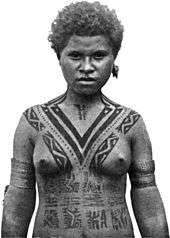Motuan people

The Motuans are native inhabitants of Papua New Guinea, living along the southern coastal area of the country. Their indigenous language is known as Motu, like several other languages of the region an Austronesian language. They and the Koitabu people are the original inhabitants and owners of the land on which Port Moresby — the national capital city — stands. The largest Motuan village is Hanuabada, northwest of Port Moresby.
Friedrich Ratzel in The History of Mankind[1] reported in 1896 on tattooing in Melanesia. Among the light-skinned Motus he found tattooing in patterns similar to those of Micronesia. He also reported, among the old women, blackening the body with a kind of earth which gives a lustre like black lead. This was said to be a sign of mourning.
Charles Gabriel Seligman came into contact with the Motuan, whom he simply referred as the Motu, in 1904. He noted that, unlike many of their neighbors in the region, the Motuan did not practice exogamy. Every year, the Motuan practiced the hiri, when community members made a trading voyages through the Gulf of Papua. Women made pottery for sale through the hiri.[2]
See also
References
- ↑ Ratzel, Friedrich (1896). www.inquirewithin.biz/history/american_pacific/oceania/melanesian-tattooing.htm "The History of Mankind" Check
|url=value (help). London: MacMillan. Retrieved October 21, 2009. - ↑ Seligman, C.G. (1910). The Melanesians of British New Guinea. Cambridge: Cambridge University Press. p. 49.